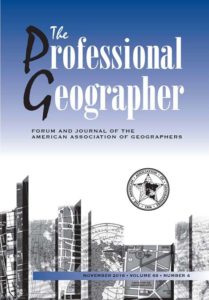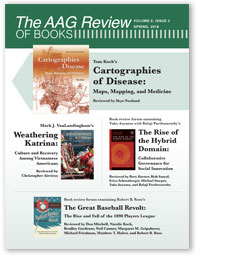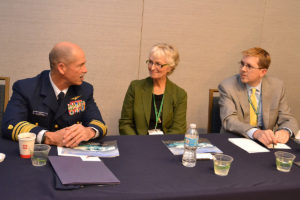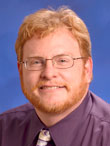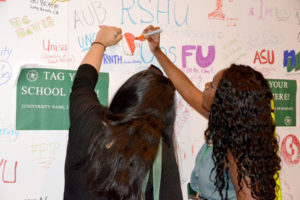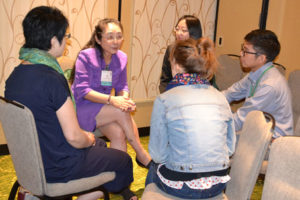Caitlin Kontgis
Education: Ph.D. in Geography (University of Wisconsin-Madison), M.S. in Environmental Health Sciences (University of California-Berkeley), B.A. in Geography (University of California-Santa Barbara)
Describe your career path following your Ph.D. up to your current position. What are the range of tasks / responsibilities for which you’ve been responsible in the positions you’ve held?
I submitted my dissertation in December 2015, but I had already begun at a company called Descartes Labs, a startup that analyzes petabytes of satellite imagery. We have a team of software engineers that deals with ingesting the data, correcting it, and building a Python-based platform to access it. I’m on the Applied Science team, and we’re using the data to generate models or maps of various land cover types. Some of this is client driven; for example, a client might come to us and want to know where all of the corn in the United States is and what the yields will be at the end of the year.
We have a pretty wide variety of clients. We work with the U.S. government, and we have a particularly cool project with DARPA assessing food security in the Middle East and North Africa. We have also worked with Cargill – they’re interested in agriculture, obviously, and we also have other sorts of commodities clients. We’ve also done work with non-profits and have contacts at World Resources Institute and National Geographic.
The project that I’m currently working on involves using radar data to map rice across Asia, so it’s sort of a return to what I was doing in my Ph.D. I started at Descartes while I was still finishing my dissertation. I was looking at a lot of jobs as I was finishing, but I wasn’t really finding jobs that seemed like the right fit or where I wanted to be geographically. I Googled “private sector jobs with remote sensing” and this small company came up – the company was only 10 people at the time. I interviewed and really liked New Mexico, the people, and the team, so I decided I’d give it a shot and have really enjoyed it.
The job has evolved since I began working here. When I started it was only about a dozen people, and there wasn’t much structure on the team. Now we’ve grown to about 75 people, so we’ve had to get quite a bit of structure in place. I lead our solutions efforts; on the Applied Science team, we’ll have customers come to the Sales team and pitch an idea, and I help the Sales team assess whether or not the idea is technically feasible. We now have a proposal process in place, where we’ll do a more in-depth review of the project to see how we would approach it, roughly how much time it would take, how many people it would require, and then go from there. I lead the team that is doing all of the solutions work and then work with the Sales team to make sure we’re not committing to something we can’t do.
Can you talk a little more about the analysis you perform – you mentioned that it’s not just limited to the U.S., correct?
Yes, we have the entire historical Landsat archive, as well as global MODIS data and European Space Agency Sentinel data across the globe. When the company was just getting off the ground our initial project was trying to predict corn yields in the United States earlier in the season and with higher accuracy than the USDA, which we did, and that’s how we got our first couple of customers. From there, we’ve looked at a variety of applications including forestry, construction, and different types of agriculture across the entire globe.
The backbone of the company is the computing systems that we have. The team that started the company came from Los Alamos National Labs, and they were experts in high performance computing. They picked up on remote sensing quite easily, then built a system that can process data very efficiently so we can scale analyses really, really rapidly. I think I processed all of the data for Asia and ran that model in less than six hours for the entire continent. That’s really the powerhouse of the company.
How has your education/background in geography prepared you for this position?
I think the thing that jumps out most obviously is having a good grasp of procedural geographic knowledge. We work with spatial data and massive amounts of satellite imagery on a regular basis, so having a thorough understanding of these kinds of data is critical to what we’re doing on the job. For example, we have a project monitoring food security in the Middle East and North Africa. Ideally, we would just choose a random assortment of points and label all of them across the region to train and test our models. However, that’s not feasible given constraints on how you can move across the area. For instance, there may not be road networks, or you might be trespassing onto private land. Thinking about how to best use the data given, that it might be quite linear and not indicative of the entire region that you may want to be sampling, is very important.
I think understanding that these issues exist and being able to creatively brainstorm how to overcome them is pretty critical for what we do, as a lot of clients that we work with may not necessarily understand those concepts as thoroughly. They’ll often come to you with a vector dataset of points, and not understand why you can’t use those points right off the bat. In order to communicate that information to clients in a way that makes sense and is easy for them to understand, you need to have a pretty deep understanding of the datasets and what’s possible or isn’t possible given the constraints of the imagery that’s being collected.
How does your knowledge of the region under analysis – for example, the landscape characteristics or the cultural/economic geography of the area – inform your overall approach in how you use these technologies and how you analyze the environments?
It’s a huge component of what we do. The most obvious example I can think of is just the climate of a region. When I was working in Vietnam during my Ph.D., I was relying on Landsat data, but for six months out of the year, you don’t get a single scene where you can actually see the landscape because of the monsoons. At Descartes, it’s been much easier because we have all of the radar data from the European Space Agency on their Sentinel-1 satellite. Radar data can be difficult to work with, but in regions like the monsoonal tropics, it’s the only way you’re going to get data throughout the whole year. Having that knowledge of where you’re actually studying and understanding those climatic impacts is crucial.
Also, there are geo-political considerations. Looking at the tariffs that are now being imposed by the United States – is China going to start sourcing all of its soybeans from Brazil now? Keeping track of that and understanding how that might affect some of the models that we’re running is critical in having a deeper understanding of the dynamics that we’re trying to study and better understand. Because some of it you can’t just explain with the satellite imagery, you have to have a broader view of what’s going on globally with politics and trade.
What have you observed in your career in terms of positive impacts in the community or for your clients? How has geography enhanced the work of your organization?
In terms of the organization, I mentioned that the company was very small when I came on and most folks on the team had a background in astrophysics or computer engineering. It was amazing and pretty humbling what they were able to do without formal training in remote sensing or geography. However, being armed with some of the knowledge that I got during my Ph.D. has been important.
Understanding the terms that people are using in more detail has also been critical. For example, if we want to map urban areas, what exactly is an urban area? We think about urban areas being San Francisco or Washington, DC or New York, but globally those are quite different and varied. In Vietnam, for example, many parts of the cities are made of vegetation, so we aren’t necessarily picking up that signal in remote sensing data the same way we would looking at San Francisco. So, bringing those ideas of geography and what constitutes a certain land cover type, or this broader picture of what the data are saying has been useful for the team. I have since recruited some of my friends out of Madison so we now have more geographers on the team, which is great, as we’re able to convey geographic concepts to the broader group. I think it just arms us better to go out and talk to other experts in the field, and better communicate with our clients as well. For the organization, I think it has been very useful to have that knowledge on the team.
In terms of our community, Santa Fe is a small town and our company is a big fish in a small pond, so we’ve been able to give back in a variety of ways. We are out and involved in the community, and everybody thinks that what we are doing is mind-blowing, so it’s fun to present our work locally. We’ve done a few presentations around town and at schools, and it’s pretty neat to watch people who have no experience or exposure to satellite imagery see what sort of things can be done with it.
When you look back at your education trajectory, how did you discover geography? How did you realize that it connects with your aspirations and your goals in life, as a private citizen, but also as a professional?
I had a really, really amazing teacher for my intro to geography course at UC Santa Barbara. I didn’t know geography was something that I could major in when I went into undergrad; I took the course to fulfill a math requirement. The course was amazing. Carl Sundbeck, the lecturer for the course, showed different images of a road trip he took in the 1970s across the entire United States. He was describing the landscape and how different mountain ranges formed, or how a city such as Los Angeles grew up where it did because of the geography of the region and why that was beneficial. Drawing these connections just sort of blew me away, and suddenly the world made sense in a way I had never thought about. And it made me want to learn about geography, obviously, so then I ended up majoring in it.
I traveled for a bit between my Bachelor’s and Master’s programs, and it was amazing making those same connections that I was making during my initial intro to geography classes. It was really exciting and made me want to continue down that path. During my Master’s degree, I was doing a lot of data processing and epidemiology work, which is very statistical and very important, but it’s just not for me. I felt stuck at my desk and not really doing the work that I wanted to be doing. I went to Vietnam the summer between the two years of my Master’s program with a friend of mine from undergrad who was from there and we stayed with her family. I felt the same way as an undergrad when I was traveling. I wanted to get back to geography and do research that was in the field, which was a lot more dynamic than what I was working on for my Master’s thesis.
I then ended up going to Madison for my Ph.D. because the woman who taught my remote sensing classes at Santa Barbara had moved there. So I went to work with her and basically went with the excuse that I wanted to continue exploring, traveling, and getting to know other cultures. I proposed to do the work in Vietnam and got it funded by NASA. I was really lucky in that regard, as I got to sort of drive my own ship. And then coming to Descartes, it just sort of continued. I’m not necessarily out in the field collecting data and interviewing farmers, but it’s still every single day looking at satellite imagery and trying to better understand the world, so it’s exploration in a different form. It’s doing a lot of exploration via satellite imagery, not necessarily boots on the ground, but it’s still fulfilling that interest.
Do you remember having an “a-ha!” moment, that perhaps changed the way you think about issues and topics? Is there another example you might have?
It definitely occurred when I was at Santa Barbara. I realized that “Wow, you can earn a living doing something that you really love!” I don’t know what I envisioned I’d be doing after college when I was 18, or what I’d be doing as a career. There was some moment at Santa Barbara when it all clicked. I remember realizing there are jobs where you can continue on a path of scientific discovery and exploration, that you don’t just have to be crunching numbers and data or doing something that’s just a job. You can do something that you really feel passionately about. You know, it probably was that first geography class, and then the same lecturer taught the follow-up class the next semester. I think at that point I was pretty hooked. At that stage, I hadn’t even taken a remote sensing class and didn’t realize what career opportunities were out there. It was just sort of like: I love this; this guy can make a living doing this, so there must be room for other people. Those first couple of classes in college were pretty crucial to where I am now.
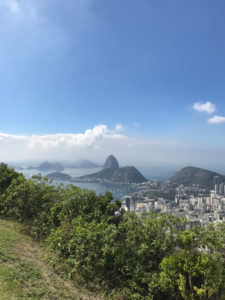 This Labor Day weekend marks the return to University instruction for many geography faculty and students, and as an educator, I welcome you all back to our academic community and wish you a successful new academic year. Many of us are returning from field and lab research, writing, and conferences, wondering where the summer went and why we are considered nine-month-employees! … For our non-academic professional Geography community, I pause to thank you for your research partnerships, your innovation and entrepreneurship, and for the internship opportunities and inspiration you offer to our students.
This Labor Day weekend marks the return to University instruction for many geography faculty and students, and as an educator, I welcome you all back to our academic community and wish you a successful new academic year. Many of us are returning from field and lab research, writing, and conferences, wondering where the summer went and why we are considered nine-month-employees! … For our non-academic professional Geography community, I pause to thank you for your research partnerships, your innovation and entrepreneurship, and for the internship opportunities and inspiration you offer to our students.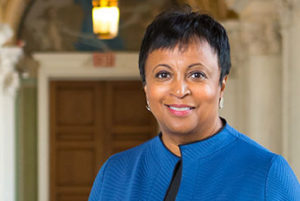 The AAG will be awarding Carla Hayden, 14th Librarian of Congress, the Atlas Award during the 2019 AAG Annual Meeting, on Friday, April 5, 2019. Hayden will deliver a keynote address after presentation of the Atlas Award, the association’s highest honor.
The AAG will be awarding Carla Hayden, 14th Librarian of Congress, the Atlas Award during the 2019 AAG Annual Meeting, on Friday, April 5, 2019. Hayden will deliver a keynote address after presentation of the Atlas Award, the association’s highest honor.

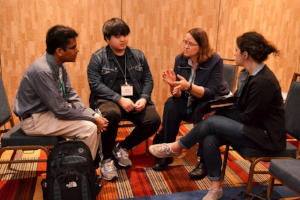 The AAG seeks panelists, mentors, and workshop leaders for careers and professional development events for its annual meeting, April 3–7, 2019, in Washington, DC. Individuals representing a broad range of employment sectors, organizations, academic and professional backgrounds, and racial/ethnic/gender perspectives are encouraged to apply. If interested, email
The AAG seeks panelists, mentors, and workshop leaders for careers and professional development events for its annual meeting, April 3–7, 2019, in Washington, DC. Individuals representing a broad range of employment sectors, organizations, academic and professional backgrounds, and racial/ethnic/gender perspectives are encouraged to apply. If interested, email  This month, get to know the editorial team of AAG’s newest journal, GeoHumanities. Two editors, Tim Cresswell and Deborah Dixon, and one assistant editor, Philip J. Nicholson, work on the journal, which includes scholarly articles at the intersection of geography and the humanities, shorter creative pieces, and an accompanying
This month, get to know the editorial team of AAG’s newest journal, GeoHumanities. Two editors, Tim Cresswell and Deborah Dixon, and one assistant editor, Philip J. Nicholson, work on the journal, which includes scholarly articles at the intersection of geography and the humanities, shorter creative pieces, and an accompanying 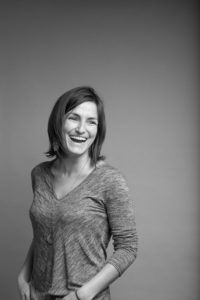 This month, learn about the career path of Caitlin Kontgis who works as an Applied Scientist Lead (Solutions) at Descartes Labs in New Mexico. Kontgis discusses her passion for geography, how it has led to her giving back to her local community, and the undergraduate courses that inspired her eventual professional goals.
This month, learn about the career path of Caitlin Kontgis who works as an Applied Scientist Lead (Solutions) at Descartes Labs in New Mexico. Kontgis discusses her passion for geography, how it has led to her giving back to her local community, and the undergraduate courses that inspired her eventual professional goals.
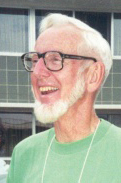 Robert Stoddard passed away on May 21, 2018 at the age of 89. Stoddard, one of the first geographers to focus on pilgrimage, was also an Asia specialist who combined his interests throughout his distinguished teaching career in the U.S. at University of Nebraska-Lincoln and abroad in India, Nepal, and Sri Lanka.
Robert Stoddard passed away on May 21, 2018 at the age of 89. Stoddard, one of the first geographers to focus on pilgrimage, was also an Asia specialist who combined his interests throughout his distinguished teaching career in the U.S. at University of Nebraska-Lincoln and abroad in India, Nepal, and Sri Lanka.
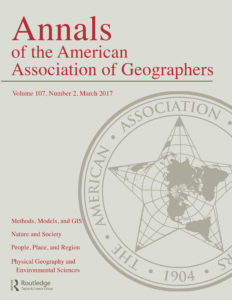

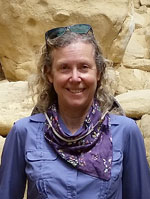 This Labor Day weekend marks the return to University instruction for many geography faculty and students, and as an educator, I welcome you all back to our academic community and wish you a successful new academic year. Many of us are returning from field and lab research, writing, and conferences, wondering where the summer went and why we are considered nine-month-employees! The answer is we are year-round members of our academic communities. Last week I wrote the final Department Chair’s welcome of my term to the UT Austin Geography community. As my term closes, I am passing the administrative baton to a wonderful colleague, to whom I give my thanks and wish all the best. I am excited for the new beginning of rejoining my fellow professors and to have more time to devote to scholarship, to my students, and to the AAG. I thank those faculty, students, and staff who helped along the journey, and thank the department chairs who will carry our missions forward.
This Labor Day weekend marks the return to University instruction for many geography faculty and students, and as an educator, I welcome you all back to our academic community and wish you a successful new academic year. Many of us are returning from field and lab research, writing, and conferences, wondering where the summer went and why we are considered nine-month-employees! The answer is we are year-round members of our academic communities. Last week I wrote the final Department Chair’s welcome of my term to the UT Austin Geography community. As my term closes, I am passing the administrative baton to a wonderful colleague, to whom I give my thanks and wish all the best. I am excited for the new beginning of rejoining my fellow professors and to have more time to devote to scholarship, to my students, and to the AAG. I thank those faculty, students, and staff who helped along the journey, and thank the department chairs who will carry our missions forward.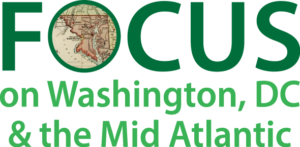 Washington, D.C. is known for its monuments, museums, and grand government buildings. It is associated with policy wonks, foreign dignitaries, and political controversy. But it is also a home town for thousands of people who live in its lively neighborhoods. How best to get a glimpse of everyday life for D.C.’s residents, those people living in places hidden from view on the National Mall? A tour of the city’s most hidden places of all: its urban alleys.
Washington, D.C. is known for its monuments, museums, and grand government buildings. It is associated with policy wonks, foreign dignitaries, and political controversy. But it is also a home town for thousands of people who live in its lively neighborhoods. How best to get a glimpse of everyday life for D.C.’s residents, those people living in places hidden from view on the National Mall? A tour of the city’s most hidden places of all: its urban alleys.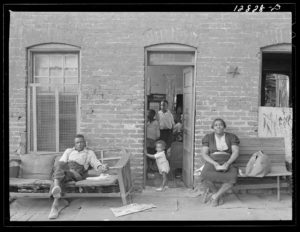


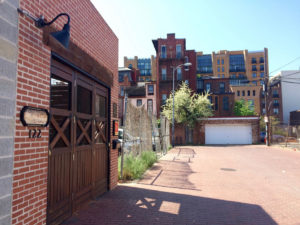

 Three long-time AAG members met up recently at the 4th International Geography Youth Summit (IGYS) in Bengaluru (formerly Bangalore), India. The IGYS was developed as part of The Institute of Geographical Studies (TIGS) in Bengaluru. Both are the brainchilds of AAG member, Dr. Chandra Shekhar Balachandran, who founded TIGS in 2000. Together with collaborators and partners in India and the US, TIGS organizes year-round workshops with teachers, parents and students in Indian urban and rural schools to introduce geography as culturally relevant and meaningful. This kind of geography challenges traditional textbook approaches and extends learning beyond the classroom.
Three long-time AAG members met up recently at the 4th International Geography Youth Summit (IGYS) in Bengaluru (formerly Bangalore), India. The IGYS was developed as part of The Institute of Geographical Studies (TIGS) in Bengaluru. Both are the brainchilds of AAG member, Dr. Chandra Shekhar Balachandran, who founded TIGS in 2000. Together with collaborators and partners in India and the US, TIGS organizes year-round workshops with teachers, parents and students in Indian urban and rural schools to introduce geography as culturally relevant and meaningful. This kind of geography challenges traditional textbook approaches and extends learning beyond the classroom. This year, Dr. Sue Roberts from the University of Kentucky attended IGYS for the first time and gave the Keynote address. She says, “What impressed me most was the way the students took geographical concepts and ran with them. They generated truly fresh ways of approaching complex problems that we adults and professionals can sometimes make rather boring” and she added “the students had no problem connecting their research findings to practical action.”
This year, Dr. Sue Roberts from the University of Kentucky attended IGYS for the first time and gave the Keynote address. She says, “What impressed me most was the way the students took geographical concepts and ran with them. They generated truly fresh ways of approaching complex problems that we adults and professionals can sometimes make rather boring” and she added “the students had no problem connecting their research findings to practical action.”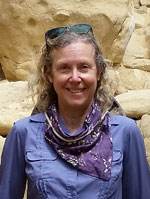
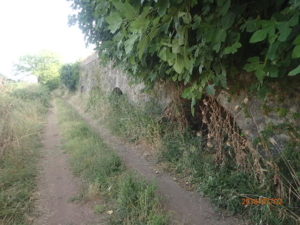
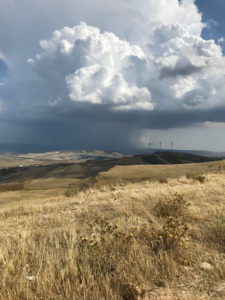
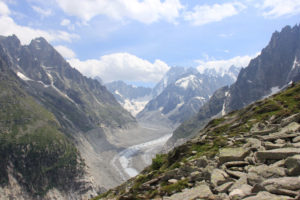
 Alex Lafler is a Junior at Michigan State University pursuing a BS in Geographic Information Science and a BA in Human Geography (along with a Minor in Environment and Health). Alex previously interned at the St. Joseph County Land Resource Centre (Centreville, MI). After Graduation, Alex hopes to pursue a career in GIS or a related field. In his spare time, Alex likes to watch movies and sports (Go Green!), walk as much as he can, and create videos and podcasts.
Alex Lafler is a Junior at Michigan State University pursuing a BS in Geographic Information Science and a BA in Human Geography (along with a Minor in Environment and Health). Alex previously interned at the St. Joseph County Land Resource Centre (Centreville, MI). After Graduation, Alex hopes to pursue a career in GIS or a related field. In his spare time, Alex likes to watch movies and sports (Go Green!), walk as much as he can, and create videos and podcasts.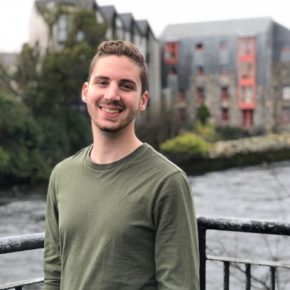 Christian Meoli is a senior at the University of Mary Washington, double majoring in Geography and Environmental Science with a certificate in GIS. He has interned for the town planning departments in his hometown of Maryland and in his college town in Virginia. Most recently he interned for the Sierra Club in Boston where he explored urban environmental geography. He hopes to bring his academic perspective and enthusiasm for geography to the AAG. In his spare time he enjoys traveling, hiking, and playing tennis.
Christian Meoli is a senior at the University of Mary Washington, double majoring in Geography and Environmental Science with a certificate in GIS. He has interned for the town planning departments in his hometown of Maryland and in his college town in Virginia. Most recently he interned for the Sierra Club in Boston where he explored urban environmental geography. He hopes to bring his academic perspective and enthusiasm for geography to the AAG. In his spare time he enjoys traveling, hiking, and playing tennis.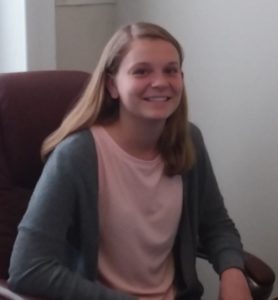 Jenny Roepe is a rising senior at Virginia Polytechnic Institute and State University, pursuing a B.A. in geography with a minor in geographical information systems and urban and public issues. Last summer Jenny interned for the Fairfax County Park Authority Planning and Development Division. During her time at FCPA, she designed trail maps using GIS software. The maps were posted for public use at various parks in Fairfax County. After graduation, Jenny hopes to pursue a career that combines her passion for the environment with her skills and background in Geographical Information Systems. In her spare time, Jenny likes to read, hike and travel to new places.
Jenny Roepe is a rising senior at Virginia Polytechnic Institute and State University, pursuing a B.A. in geography with a minor in geographical information systems and urban and public issues. Last summer Jenny interned for the Fairfax County Park Authority Planning and Development Division. During her time at FCPA, she designed trail maps using GIS software. The maps were posted for public use at various parks in Fairfax County. After graduation, Jenny hopes to pursue a career that combines her passion for the environment with her skills and background in Geographical Information Systems. In her spare time, Jenny likes to read, hike and travel to new places.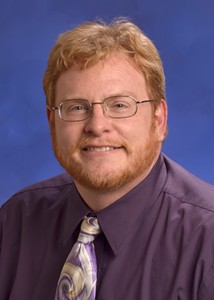 This marks my last presidential column. Serving as President of the Association over the past year has been a true pleasure and honor. I have appreciated the opportunity to represent you and the discipline of geography. As someone who first began attending AAG meetings as a young graduate student, I never dreamed that one day that I would be allowed to serve in this capacity. I am a direct product of the type of significant investments that my academic programs, employers, mentors, and my Association have made in me over the years. Thank you.
This marks my last presidential column. Serving as President of the Association over the past year has been a true pleasure and honor. I have appreciated the opportunity to represent you and the discipline of geography. As someone who first began attending AAG meetings as a young graduate student, I never dreamed that one day that I would be allowed to serve in this capacity. I am a direct product of the type of significant investments that my academic programs, employers, mentors, and my Association have made in me over the years. Thank you.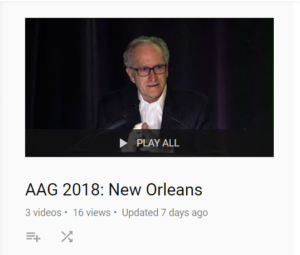 If you missed or want to review the high-profile sessions from AAG 2018 New Orleans, you can now watch recordings of these events on the AAG YouTube channel. Available videos include the Opening Session with welcoming remarks from Executive Director Doug Richardson and Mayor-Elect LaToya Cantrell followed by Derek Alderman’s Presidential Plenary, Glen MacDonald’s Past President’s Address, and Honorary Geographer Robert Bullard’s talk.
If you missed or want to review the high-profile sessions from AAG 2018 New Orleans, you can now watch recordings of these events on the AAG YouTube channel. Available videos include the Opening Session with welcoming remarks from Executive Director Doug Richardson and Mayor-Elect LaToya Cantrell followed by Derek Alderman’s Presidential Plenary, Glen MacDonald’s Past President’s Address, and Honorary Geographer Robert Bullard’s talk.
 AAG continues to monitor and update you on key issues that have a clear impact on geography or in which our discipline can serve as a valued stakeholder in shaping viewpoints and policy outcomes. Recent activities by the AAG include support for funding for the National Agriculture Imagery Program through a sign-on letter. In addition, AAG reports on a House Appropriations Bill, which provides significant increases for the National Science Foundation and the U.S. Census Bureau. AAG also lists information on its policy page to help you take action within your communities.
AAG continues to monitor and update you on key issues that have a clear impact on geography or in which our discipline can serve as a valued stakeholder in shaping viewpoints and policy outcomes. Recent activities by the AAG include support for funding for the National Agriculture Imagery Program through a sign-on letter. In addition, AAG reports on a House Appropriations Bill, which provides significant increases for the National Science Foundation and the U.S. Census Bureau. AAG also lists information on its policy page to help you take action within your communities.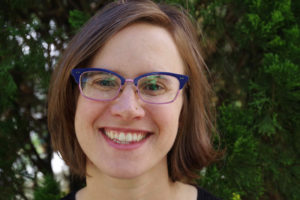
 When it comes to landing a career in geography, Bishop and Shabram agree, the most important thing is to have experience either in the classroom to be an educator or in the field to work in international studies and research. Read more about the two working geographers interviewed this month, Kate Bishop an Evaluation Consultant at Winrock International and Visiting Assistant Lecturer at University of New England in the Department of Environmental Studies and Patrick Shabram a Professor of Geography at Front Range Community College on the Larimer Campus, in AAG’s Profiles of Professional Geographers.
When it comes to landing a career in geography, Bishop and Shabram agree, the most important thing is to have experience either in the classroom to be an educator or in the field to work in international studies and research. Read more about the two working geographers interviewed this month, Kate Bishop an Evaluation Consultant at Winrock International and Visiting Assistant Lecturer at University of New England in the Department of Environmental Studies and Patrick Shabram a Professor of Geography at Front Range Community College on the Larimer Campus, in AAG’s Profiles of Professional Geographers.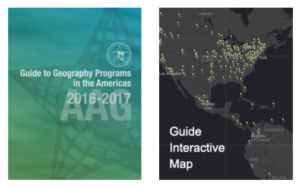 While the deadline for submitting materials for the 2018 Guide has passed, the AAG will continue to accept late submissions through Tuesday, June 12, 2018. Updated each academic year, the Guide is an invaluable reference for students and faculty throughout the world and includes detailed information on hundreds of geography programs in the U.S., Canada, and Latin America, including: program specialties, degrees offered, application requirements, curricula, faculty listings and qualifications, financial assistance, degrees completed, and more! Your program will also appear alongside hundreds of other top geography programs in our
While the deadline for submitting materials for the 2018 Guide has passed, the AAG will continue to accept late submissions through Tuesday, June 12, 2018. Updated each academic year, the Guide is an invaluable reference for students and faculty throughout the world and includes detailed information on hundreds of geography programs in the U.S., Canada, and Latin America, including: program specialties, degrees offered, application requirements, curricula, faculty listings and qualifications, financial assistance, degrees completed, and more! Your program will also appear alongside hundreds of other top geography programs in our 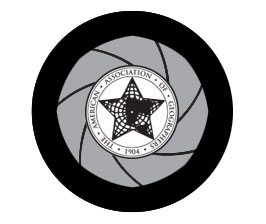 Curious to know more about the more than 43 annual awards the AAG administers on an annual basis? Is there a colleague that is deserving of an AAG honor? The AAG Grants and Awards program offers a variety of ways to recognize deserving geographers for their commitment to the discipline, their students, and their communities as well as application programs for students to obtain assistance for travel or research. This AAG Snapshot provides insight into getting involved in the AAG Grants and Awards program from multiple avenues.
Curious to know more about the more than 43 annual awards the AAG administers on an annual basis? Is there a colleague that is deserving of an AAG honor? The AAG Grants and Awards program offers a variety of ways to recognize deserving geographers for their commitment to the discipline, their students, and their communities as well as application programs for students to obtain assistance for travel or research. This AAG Snapshot provides insight into getting involved in the AAG Grants and Awards program from multiple avenues.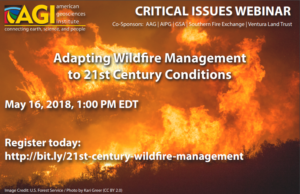 AGI Wildfire Management Webinar Video Available
AGI Wildfire Management Webinar Video Available Please consider nominating outstanding colleagues for the
Please consider nominating outstanding colleagues for the 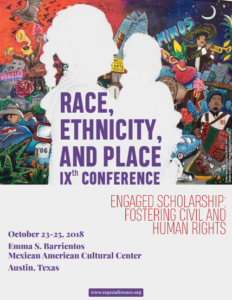
 Former Director of the National Snow and Ice Data Center and Distinguished Professor at University of Colorado, Roger Barry, passed away on March 19, 2018. Barry was 82 years old. Known for his work in polar and mountain climates, Barry received numerous academic accolades throughout his lifetime and contributed to the Intergovernmental Panel on Climate Change (IPCC) assessments in 1990, 1995, and 2001 as well as served as a review editor for IPCC Working Groups 1 and 2 in 2007, an effort that earned the IPCC the Nobel Peace Prize.
Former Director of the National Snow and Ice Data Center and Distinguished Professor at University of Colorado, Roger Barry, passed away on March 19, 2018. Barry was 82 years old. Known for his work in polar and mountain climates, Barry received numerous academic accolades throughout his lifetime and contributed to the Intergovernmental Panel on Climate Change (IPCC) assessments in 1990, 1995, and 2001 as well as served as a review editor for IPCC Working Groups 1 and 2 in 2007, an effort that earned the IPCC the Nobel Peace Prize.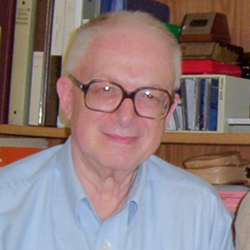 Ohio State Department of Geography Emeratis Professor, Emilio Casetti, passed away on January 11, 2018. Casetti was a professor at Ohio State from 1963 until his retirement in 1993. Holding a doctorate from Northwestern University in Mathematical Modeling, Casetti contributed to the growth of geographical analysis techniques.
Ohio State Department of Geography Emeratis Professor, Emilio Casetti, passed away on January 11, 2018. Casetti was a professor at Ohio State from 1963 until his retirement in 1993. Holding a doctorate from Northwestern University in Mathematical Modeling, Casetti contributed to the growth of geographical analysis techniques. Geographer and sustainability scientist, Robert W. Kates, died the day before Earth Day, on April 21, 2018, at the age of 89. Though Kates had a varied career, most recently as Presidential Professor of Sustainability Science at the University of Maine, his work was grounded in big picture questions of sustainability and the question of “What is, and ought to be, the human use of the earth?” Kates has been honored with a variety of awards throughout his life including being the recipient in the first annual MacArthur Fellowship in 1981.
Geographer and sustainability scientist, Robert W. Kates, died the day before Earth Day, on April 21, 2018, at the age of 89. Though Kates had a varied career, most recently as Presidential Professor of Sustainability Science at the University of Maine, his work was grounded in big picture questions of sustainability and the question of “What is, and ought to be, the human use of the earth?” Kates has been honored with a variety of awards throughout his life including being the recipient in the first annual MacArthur Fellowship in 1981. GeoHumanities features articles that span conceptual and methodological debates in geography and the humanities; critical reflections on analog and digital artistic productions; and new scholarly interactions occurring at the intersections of geography and multiple humanities disciplines. There are full length scholarly articles in the Articles section and shorter creative pieces that cross over between the academy and creative practice in the Practices and Curations section.
GeoHumanities features articles that span conceptual and methodological debates in geography and the humanities; critical reflections on analog and digital artistic productions; and new scholarly interactions occurring at the intersections of geography and multiple humanities disciplines. There are full length scholarly articles in the Articles section and shorter creative pieces that cross over between the academy and creative practice in the Practices and Curations section.